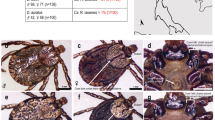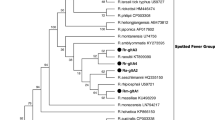Abstract
Three Australian native animal species yielded 60 samples composed of three indigenous ticks. Hosts included twelve koalas, two echidnas and one wombat from Victoria, and ticks were of the species Ixodes tasmani (n = 42), Bothriocroton concolor (n = 8) and B. auruginans (n = 10), respectively. PCR screening and sequencing detected a species of Coxiella, sharing closest sequence identity to C. burnetii (>98%), in all B. auruginans, as well as a species of Rickettsia, matching closest to R. massiliae, in 70% of the same samples. A genotype sharing closest similarity to Rickettsia bellii (>99%) was identified in three female B. concolor collected from one of the echidnas. Three samples of I. tasmani, taken from three koalas, yielded different genotypes of Rickettsiella. These results represent the first detection of the three genera in each tick species and identify a high level of previously undetected bacterial diversity in Australian ticks.





Similar content being viewed by others
References
Adamo SA (1998) The specificity of behavioral fever in the cricket Acheta domesticus. J Parasitol 84:529–533. doi:10.2307/3284717
Altschul SF, Madden TL, Schäffer AA et al (1997) Gapped BLAST and PSI-BLAST: a new generation of protein database search programs. Nucleic Acids Res 25:3389–3402. doi:10.1093/nar/25.17.3389
Bernasconi MV, Casati S, Peter O et al (2002) Rhipicephalus ticks infected with Rickettsia and Coxiella in southern Switzerland (Canton Ticino). Infect Genet Evol 2:111–120. doi:10.1016/S1567-1348(02)00092-8
Blanc G, Ogata H, Robert C et al (2007) Reductive genome evolution from the mother of Rickettsia. PLoS Genet 3:e14. doi:10.1371/journal.pgen.0030014
Cordaux R, Paces-Fessy M, Raimond M et al (2007) Molecular characterization and evolution of arthropod-pathogenic Rickettsiella bacteria. Appl Environ Microbiol 73:5045–5047. doi:10.1128/AEM.00378-07
Cutler SJ, Bouzid M, Cutler R (2006) Q fever. J Infect 54:313–318. doi:10.1016/j.jinf.2006.10.048
Eremeeva ME, Bosserman EA, Demma LJ et al (2006) Isolation and identification of Rickettsia massiliae from Rhipicephalus sanguineus ticks collected in Arizona. Appl Environ Microbiol 72:5569–5577. doi:10.1128/AEM.00122-06
Felsenstein J (1989) PHYLIP–Phylogeny Inference Package (Version 3.2). Cladistics 5:164–166
Frutos R, Federici BA, Revet B et al (1994) Taxonomic studies of Rickettsiella, Rickettsia and Chlamydia using genomic DNA. J Invertebr Pathol 63:294–300. doi:10.1006/jipa.1994.1054
Gillespie JJ, Beier MS, Rahman MS et al (2007) Plasmids and Rickettsial evolution: insight from Rickettsia felis. PLoS One 2:e266. doi:10.1371/journal.pone.0000266
Greub G, Lepidi H, Rovery C et al (2005) Diagnosis of infectious endocarditis in patients undergoing valve surgery. Am J Med 118:230–238. doi:10.1016/j.amjmed.2004.12.014
Hoover TA, Vodkin MH, Williams JC (1992) A Coxiella burnetii repeated DNA element resembling bacterial insertion sequence. J Bacteriol 174:5540–5548
Jasinskas A, Zhong J, Barbour AG (2007) Highly prevalent Coxiella sp. bacterium in the tick vector Amblyomma americanum. Appl Environ Microbiol 73:334–336. doi:10.1128/AEM.02009-06
Kazar J (2005) Coxiella burnetii infection. Ann N Y Acad Sci 1063:105–114. doi:10.1196/annals.1355.018
Kim C, Yi Y, Yu D et al (2006) Tick-borne rickettsial pathogens in ticks and small mammals in Korea. Appl Environ Microbiol 72:5766–5776. doi:10.1128/AEM.00431-06
Klompen H, Dobson SJ, Barker SC (2002) A new subfamily, Bothriocrotoninae n. subfam., for the genus Bothriocroton Keirans, King and Sharrad, 1994 status amend. (Ixodida: Ixodidae), and the synonymy of Aponomma Neumann, 1899 with Amblyomma Koch 1844. Syst Parasitol 53:101–107. doi:10.1023/A:1020466007722
Kurtti TJ, Palmer AT, Oliver JHJ (2002) Rickettsiella-like bacteria in Ixodes woodi (Acari: Ixodidae). J Med Entomol 39:534–540
Labruna MB, Whitworth T, Bouyer DH et al (2004) Rickettsia bellii and Rickettsia amblyommii in Amblyomma ticks from the state of Rodonia, Western Amazon, Brazil. J Med Entomol 41:1073–1081
Mediannikov OY, Ivanov L, Nishikawa M et al (2003) Molecular evidence of Coxiella-like microorganism by Haemaphysalis cocinnae ticks in the Russian Far East. Ann N Y Acad Sci 990:226–228
Murdoch FA, Spratt DM (2005) Ecology of the marsupial tick (Ixodes tasmani Neumann) (Acarina: Ixodidae), in eastern Australia. Aust J Zool 53:383–388. doi:10.1071/ZO05032
Noda H, Munderloh UG, Kurtti TJ (1997) Endosymbionts of ticks and their relationship to Wolbachia spp. and tick-borne pathogens of humans and animals. Appl Environ Microbiol 63:3926–3932
Ogata H, La Scola B, Audic S et al (2006) Genome sequence of Rickettsia bellii illuminates the role of amoebae in gene exchanges between intracellular pathogens. PLoS Genet 2:e76. doi:10.1371/journal.pgen.0020076
Parola P, Cornet JP, Sanogo YO et al (2003) Detection of Ehrlichia spp., Anaplasma spp., Rickettsia spp., and other eubacteria in ticks from the Thai-Myanmar border and Vietnam. J Clin Microbiol 41:1600–1608. doi:10.1128/JCM.41.4.1600-1608.2003
Perlman SJ, Hunter MS, Zchori-Fein E (2006) The emerging diversity of Rickettsia. Proc R Soc Biol 273:2097–2106. doi:10.1098/rspb.2006.3541
Perotti MA, Clarke HK, Turner BD et al (2006) Rickettsia as obligate and mycetomic bacteria. FASEB J 20:1646–1656. doi:10.1096/fj.06-5870fje
Psaroulaki A, Ragiadakou D, Kouris G et al (2006) Ticks, tick-borne Rickettsiae, and Coxiella burnetii in the Greek Island of Cephalonia. Ann N Y Acad Sci 1078:389–399. doi:10.1196/annals.1374.077
Reeves WK, Loftis AD, Priestley RA et al (2005) Molecular and biological characterization of a novel Coxiella-like agent from Carios capensis. Ann N Y Acad Sci 1063:343–345. doi:10.1196/annals.1355.055
Regnery RL, Spruill CL, Plikaytis BD (1991) Genotypic identification of rickettsiae and estimation of intraspecies sequence divergence for portions of two rickettsial genes. J Bacteriol 173:1576–1589
Roberts FHS (1970) Australian ticks. CSIRO, Melbourne
Roux V, Raoult D (2000) Phylogenetic analysis of members of the genus Rickettsia using the gene encoding the outer-membrane protein rOmpB (ompB). Int J Syst Evol Microbiol 50:1449–1455
Roux V, Bergoin M, Lamaze N et al (1997a) Reassessment of the taxonomic position of Rickettsiella grylli. Int J Syst Bacteriol 47:1255–1257
Roux V, Rydkina E, Eremeeva M et al (1997b) Citrate synthase gene comparison, a new tool for phylogenetic analysis, and its application for the Rickettsiae. Int J Syst Bacteriol 47:252–261
Seshadri R, Samuel JE (2005) Genome analysis of Coxiella burnetii species: insights into pathogenesis and evolution of implications for biodefense. Ann N Y Acad Sci 1063:442–450. doi:10.1196/annals.1355.063
Seshadri R, Paulsen IT, Eisen JA et al (2003) Complete genome sequence of the Q-fever pathogen Coxiella burnetii. Proc Natl Acad Sci USA 100:5455–5460. doi:10.1073/pnas.0931379100
Sjöstedt A, Goransson I, Macellaro A et al (1998) Genotypic and phenotypic characterization of two Swedish isolates and two prototypic strains of Coxiella burnetii. FEMS Immunol Med Microbiol 20:165–172
Spencer AJ, Canfield P (1993) Haematological characterisation of heavy tick infestation in koalas (Phascolarctos cinereus). Comp Haematol Int 3:225–229. doi:10.1007/BF02341970
Stein A, Saunders NA, Taylor AG et al (1993) Phylogenetic homogeneity of Coxiella burnetii strains as determined by 16S ribosomal RNA sequencing. FEMS Microbiol Lett 113:339–344. doi:10.1111/j.1574-6968.1993.tb06537.x
Tan CK, Owens L (2000) Infectivity, transmission and 16S rRNA sequencing of a rickettsia, Coxiella cheraxi sp. nov., from the freshwater crayfish Cherax quadricarinatus. Dis Aq Org 41:115–122. doi:10.3354/dao041115
Thompson JD, Higgins DG, Gibson TJ (1994) CLUSTAL W: improving the sensitivity of progressive multiple sequence alignment through sequence weighting, position-specific gap penalties and weight matrix choice. Nucleic Acids Res 22:4673–4680. doi:10.1093/nar/22.22.4673
Unsworth N, Stenos J, Fas AG et al (2007a) Three Rickettsioses, Darney Island, Australia. Emerg Infect Dis 13:1105–1107
Unsworth N, Stenos J, Graves SR et al (2007b) Flinders Island spotted fever Rickettsiosis caused by “marmionii” strain of Rickettsia honei, Eastern Australia. Emerg Infect Dis 13:566–573
Vilcins I-M, Old J, Deane E (2005) The impact of ticks and tick-borne diseases on native animal species in Australia. Microbiol Aust 26(2):76–79
Vitale G, Mansueto S, Rolain JM et al (2006) Rickettsia massiliae human isolation. Emerg Infect Dis 12:174–175
Weisburg WG, Dobson ME, Samuel JE et al (1989) Phylogenetic diversity of the Rickettsiae. J Bacteriol 171:4202–4206
Acknowledgments
We thank Ashley Reed and staff from the Koala Conservation Centre at Philip Island, Victoria, for the collection of ticks during routine health inspections of the wild koala population. We would also like to thank Peter Holz from Healseville sanctuary, Victoria, for the collection of ticks from captive and wild animals. We would like to thank Annick Bernard for her technical assistance and advice. This research was supported by a Macquarie University Postgraduate scholarship to Vilcins.
Author information
Authors and Affiliations
Corresponding author
Electronic supplementary material
Below is the link to the electronic supplementary material.
Rights and permissions
About this article
Cite this article
Vilcins, IM.E., Old, J.M. & Deane, E. Molecular detection of Rickettsia, Coxiella and Rickettsiella DNA in three native Australian tick species. Exp Appl Acarol 49, 229–242 (2009). https://doi.org/10.1007/s10493-009-9260-4
Received:
Accepted:
Published:
Issue Date:
DOI: https://doi.org/10.1007/s10493-009-9260-4




